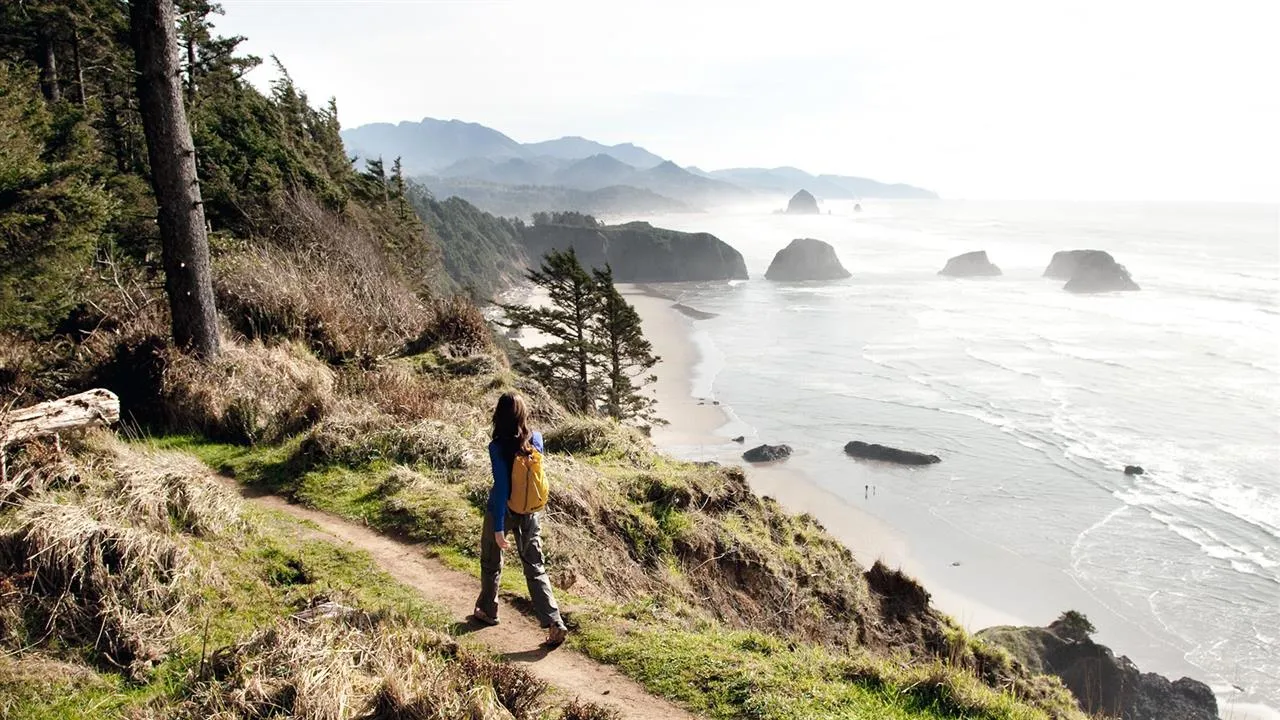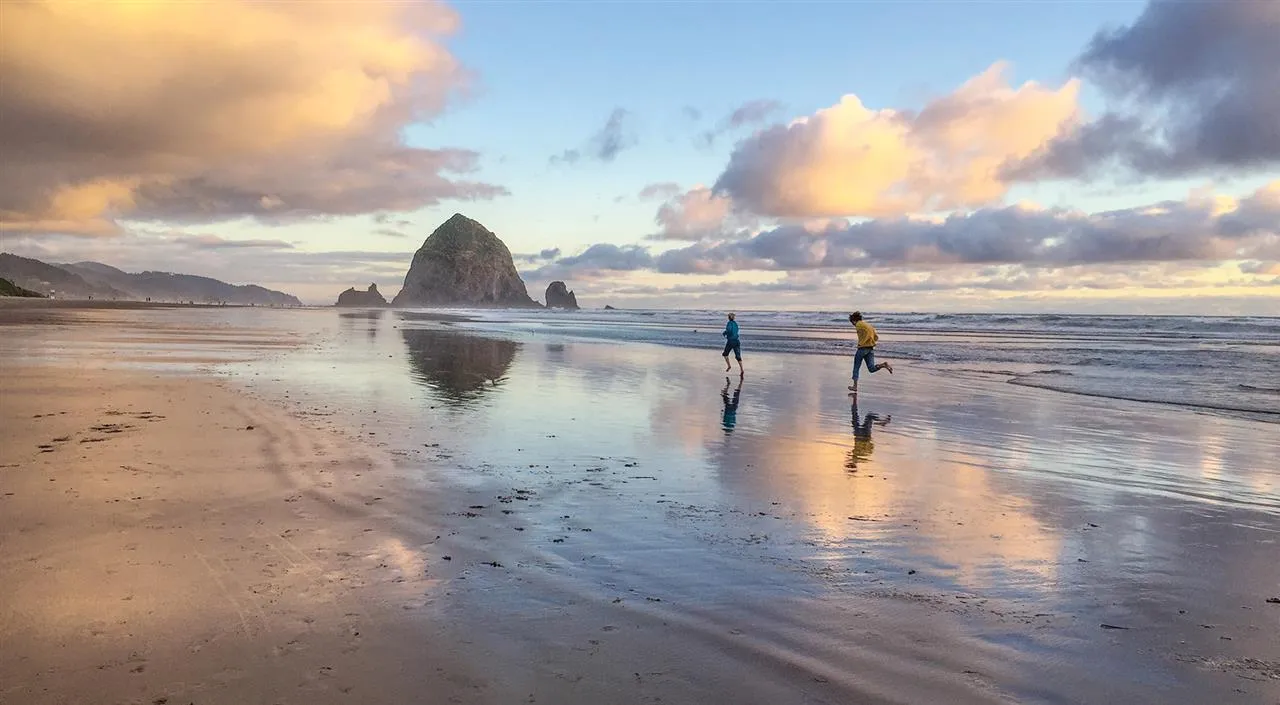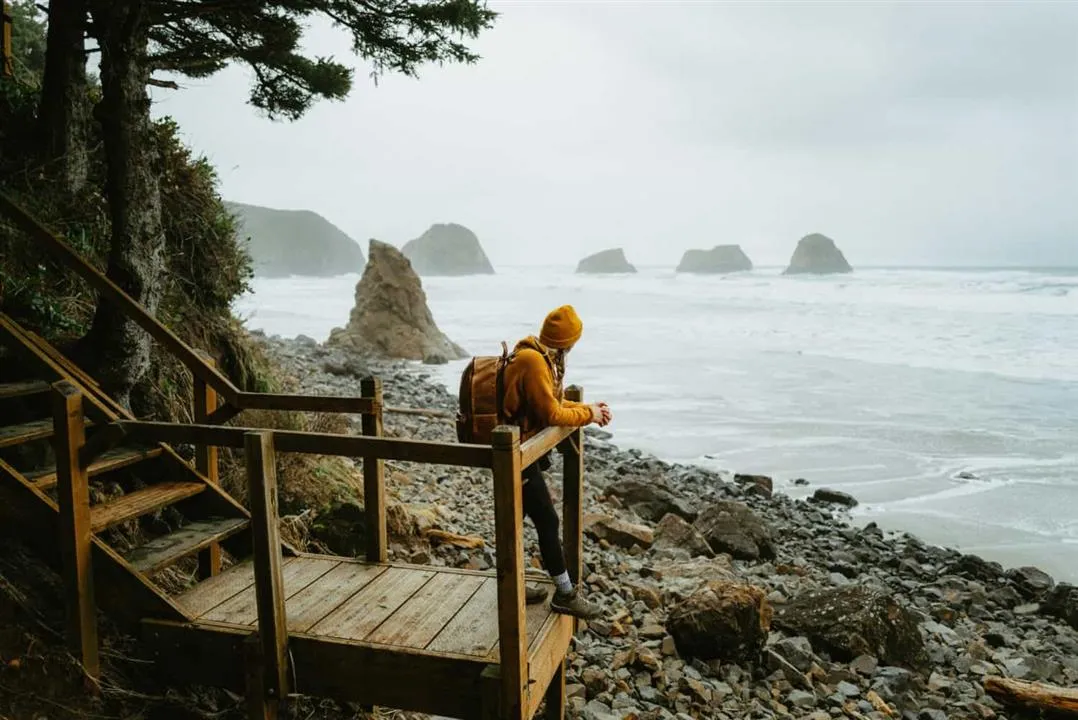Summer is the perfect time to explore stunning beaches, and Oregon, with its 580km+ coastline, is always an attractive destination. Beyond its magnificent scenery, Oregon offers a unique experience rarely found elsewhere: driving directly on the beach. Join “Du lịch khắp thế gian” to discover the essentials of driving on Oregon beaches, turning your trip into an unforgettable adventure.
Why is driving on Oregon beaches special?
Oregon is one of the few states in the US that allows driving on designated beaches. This offers not only convenient beach access but also a unique adventurous experience. Imagine being behind the wheel, your car gliding across the smooth sand, with the rhythmic ocean waves beside you and the vast, untouched natural scenery stretching to the horizon. This is the distinctive appeal of driving on Oregon beaches.
More than just transportation, driving on Oregon beaches is a way to connect with nature. You can easily stop anywhere to soak in the views, camp, fish, or simply relax and breathe in the fresh sea air. It’s a truly liberating and nature-immersive travel experience unlike any other.
Things to Know Before Driving on Oregon Beaches
As wonderful as it is, driving on Oregon beaches requires preparation and adherence to certain rules to ensure safety and environmental protection. Here are essential things to keep in mind:
1. Understand the Rules and Regulations
Not all Oregon beaches permit driving. Some areas may prohibit motorized vehicles to protect ecosystems or ensure pedestrian safety. Before you go, thoroughly research the specific beach you plan to visit. The official websites of the Oregon Parks and Recreation Department (OPRD) are the most reliable sources of information.
Also, pay attention to signs and instructions at the beach. Regulations can vary depending on the season and weather conditions. Always adhere to the speed limit, typically 25 mph (40 km/h) on beaches, and yield to pedestrians, children, and wildlife.
2. Check Beach and Tide Conditions
Beach conditions can change dramatically depending on weather and tides. Beaches can become soft and boggy after heavy rain or high tides. Driving on wet, soft sand is more challenging and increases the risk of getting stuck.
Before driving, check the weather forecast and tide charts. Avoid driving during rising tides or when severe weather warnings are in effect. It’s best to drive during low tide when the beach is wider and the sand is firmer. You can find tide information online or at local tourist information centers.
3. Choose the Right Vehicle and Inspect It
Not every vehicle is suitable for beach driving. Four-wheel drive (4WD) or all-wheel drive (AWD) vehicles are the best choices because they offer better traction on soft sand. However, even with a 4WD/AWD vehicle, you still need to be careful and well-prepared.
Before you go, inspect your vehicle, especially the tires, brakes, and engine. Ensure your tires are properly inflated, but consider reducing tire pressure to about 15-20 psi (1-1.4 bar) when driving on soft sand. This increases the tire’s contact area with the sand, improving grip and reducing the risk of sinking. Remember to reinflate your tires to the recommended pressure when you return to paved roads.

Popular Oregon Beaches for Driving
Oregon boasts many stunning beaches that allow driving, each offering unique beauty and experiences. Here are a few suggestions:
1. Astoria and Warrenton Long Beaches
The Astoria and Warrenton area in Northern Oregon features vast, flat beaches stretching for miles. These are ideal for leisurely drives, scenic views, and enjoying the vastness of the ocean. Sunset Beach in Warrenton and Fort Stevens State Park beach are popular choices. At Fort Stevens State Park, you can also explore the famous Peter Iredale shipwreck, a historical and fascinating attraction.
2. Pacific City and Nestucca Area Beaches
Pacific City is famous for its majestic Haystack Rock and wide, flat beach, perfect for driving. The nearby Nestucca National Wildlife Refuge also offers beautiful and pristine beaches. You can drive along the beach, stop for camping, fishing, or simply watch the stunning sunset over the Pacific Ocean.
3. Tierra Del Mar Beach
Located just south of Pacific City, Tierra Del Mar is a smaller but tranquil and charming beach. This beach also allows driving and is a great destination to escape the hustle and bustle. Drive to the end of the beach to explore cliffs and small caves, or relax and enjoy the privacy.
4. Cannon Beach – Special Note
Cannon Beach, with its iconic Haystack Rock, is also a must-visit in Oregon. However, note that driving on Cannon Beach is more restricted than on other beaches. Typically, only certain areas permit driving, and parking can be challenging, especially during peak season.

If you want to experience Cannon Beach by car, research the regulations and permitted driving areas before visiting. Alternatively, consider other nearby beaches like Arch Cape or Manzanita Beach, which also offer stunning scenery and fewer driving restrictions.
Tips for Safe Beach Driving in Oregon
Driving on the beach is an exciting experience, but it also carries risks if you’re not careful. Here are some tips for safe driving and maximizing your trip:
1. Maintain Steady Speed and Avoid Sudden Braking
When driving on sand, maintain a steady speed and avoid sudden braking or acceleration. Soft sand can reduce tire grip, making it easy to skid or lose control. Driving slowly and smoothly will help you maintain better control and avoid dangerous situations.
2. Drive in Existing Tracks
If possible, drive in existing tire tracks on the beach. The sand in these tracks is usually more compacted, making it easier for your vehicle to move and reducing the risk of sinking. Avoid driving on soft, loose sand, especially near the water’s edge or in areas showing signs of sinking.
3. Pay Attention to Terrain and Obstacles
Beaches are not always flat. There may be sand dunes, water channels, rocks, or debris washed ashore. Observe the terrain ahead and avoid obstacles. If you encounter high dunes, drive slowly and cross them gradually, keeping your vehicle straight and avoiding sharp turns.
4. Know How to Handle a Stuck Vehicle
Even with a 4WD/AWD vehicle and careful preparation, your vehicle can still get stuck in soft sand. It’s crucial to know how to handle this situation.
- Stay Calm: Don’t panic and try to floor the gas pedal. This will only make the wheels spin and sink deeper.
- Reduce Tire Pressure: If you haven’t already, try reducing tire pressure to about 15-20 psi.
- Dig Around the Tires: Use a shovel or your hands to dig sand away from around the stuck tires, creating space for them to move.
- Place Boards or Support Material Under Tires: If you have wooden boards, mats, or similar materials, place them under the tires to increase traction.
- Gently Accelerate and Reverse: Try gently accelerating and reversing the vehicle, combined with slight steering, to find a way out.
- Seek Help: If you can’t manage on your own, don’t hesitate to ask for help from others or call a vehicle recovery service.

Essential Vehicle and Gear Preparation
To ensure your Oregon beach driving trip is smooth and safe, prepare the following essential items:
- Shovel: For digging sand if your vehicle gets stuck.
- Boards or Mats: To place under tires for better traction.
- Tire Pressure Gauge: To check and adjust tire pressure.
- Portable Tire Inflator: To reinflate tires after beach driving.
- Tow Rope: To pull your vehicle out of a sink if needed.
- Basic Car Repair Kit: To handle minor issues.
- Drinking Water and Food: In case of vehicle trouble and waiting time.
- Mobile Phone and Power Bank: For communication in emergencies.
- Map and GPS: For navigation and directions.
- Sunscreen, Hat, Sunglasses: To protect skin and eyes from the sun.
- Jacket and Blanket: Oregon coast weather can change quickly, so prepare warm clothing.
- Trash Bags: To collect trash and keep the beach clean.
Oregon Beach Driving Culture: Respect and Protect
Driving on Oregon beaches is not just a recreational activity; it’s also part of the local culture. Oregonians deeply cherish and take pride in their coastline. When driving on the beach, show respect and protect the natural environment.
- Stay on Designated Areas: Adhere to permitted driving zones and avoid restricted areas.
- No Littering: Bring trash bags and collect all your waste. Do not leave trash on the beach or in the ocean.
- Prevent Pollution: Avoid spilling fuel, oil, or other pollutants on the beach.
- Respect Wildlife: Beaches are habitats for many wildlife species. Keep a safe distance and do not disturb them.
- Share the Space: Beaches are public spaces, share them respectfully with pedestrians, swimmers, and others.
- Leave Only Footprints, Take Nothing but Trash: Help keep Oregon beaches clean, beautiful, and pristine for future generations.
Conclusion
Driving on Oregon beaches is a unique and memorable travel experience. With thorough preparation, knowledge of regulations, and safe driving skills, you can fully enjoy the magnificent beauty of the Oregon coast and create unforgettable memories. Remember that respecting nature and adhering to rules are key to protecting the environment and maintaining this wonderful experience for everyone. Have a fantastic and safe trip on the beautiful beaches of Oregon!